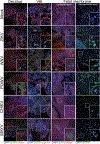Zika virus-related neurotropic flaviviruses infect human placental explants and cause fetal demise in mice
- PMID: 29386359
- PMCID: PMC6136894
- DOI: 10.1126/scitranslmed.aao7090
Zika virus-related neurotropic flaviviruses infect human placental explants and cause fetal demise in mice
Abstract
Although Zika virus (ZIKV) infection in pregnant women can cause placental damage, intrauterine growth restriction, microcephaly, and fetal demise, these disease manifestations only became apparent in the context of a large epidemic in the Americas. We hypothesized that ZIKV is not unique among arboviruses in its ability to cause congenital infection. To evaluate this, we tested the capacity of four emerging arboviruses [West Nile virus (WNV), Powassan virus (POWV), chikungunya virus (CHIKV), and Mayaro virus (MAYV)] from related (flavivirus) and unrelated (alphavirus) genera to infect the placenta and fetus in immunocompetent, wild-type mice. Although all four viruses caused placental infection, only infection with the neurotropic flaviviruses (WNV and POWV) resulted in fetal demise. WNV and POWV also replicated efficiently in second-trimester human maternal (decidua) and fetal (chorionic villi and fetal membrane) explants, whereas CHIKV and MAYV replicated less efficiently. In mice, RNA in situ hybridization and histopathological analysis revealed that WNV infected the placenta and fetal central nervous system, causing injury to the developing brain. In comparison, CHIKV and MAYV did not cause substantive placental or fetal damage despite evidence of vertical transmission. On the basis of the susceptibility of human maternal and fetal tissue explants and pathogenesis experiments in immunocompetent mice, other emerging neurotropic flaviviruses may share with ZIKV the capacity for transplacental transmission, as well as subsequent infection and injury to the developing fetus.
Copyright © 2018 The Authors, some rights reserved; exclusive licensee American Association for the Advancement of Science. No claim to original U.S. Government Works.
Conflict of interest statement
Figures






References
-
- Dick GW, Kitchen SF, Haddow AJ, Zika virus. I. Isolations and serological specificity. Transactions of the Royal Society of Tropical Medicine and Hygiene 46, 509–520 (1952). - PubMed
-
- de Oliveira WK, de França GVA, Carmo EH, Duncan BB, de Souza Kuchenbecker R, Schmidt MI, Infection-related microcephaly after the 2015 and 2016 Zika virus outbreaks in Brazil: a surveillance-based analysis. The Lancet, 390, 861–870 (2017). - PubMed
-
- Yuan L, Huang XY, Liu ZY, Zhang F, Zhu XL, Yu JY, Ji X, Xu YP, Li G, Li C, Wang HJ, Deng YQ, Wu M, Cheng ML, Ye Q, Xie DY, Li XF, Wang X, Shi W, Hu B, Shi PY, Xu Z, Qin CF, A single mutation in the prM protein of Zika virus contributes to fetal microcephaly. Science (New York, N.Y.), 358, 933–936 (2017). - PubMed
Publication types
MeSH terms
Grants and funding
LinkOut - more resources
Full Text Sources
Other Literature Sources

